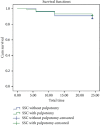Comparison of Survival Rates of Stainless-Steel Crowns Placed with and without Pulpotomy: A Two-Year Retrospective Study
- PMID: 33144859
- PMCID: PMC7599394
- DOI: 10.1155/2020/8883189
Comparison of Survival Rates of Stainless-Steel Crowns Placed with and without Pulpotomy: A Two-Year Retrospective Study
Abstract
Aim: This study aimed to retrospectively compare the survival outcomes over two years between teeth with proximal dental caries that were restored with stainless-steel crowns to those that were pulpotomized and then restored with a stainless-steel crown in patients who were rehabilitated under general anesthesia. Participants and Methods. The records of 131 patients aged between two to six years who had stainless-steel crowns placed under general anesthesia and had two-year follow-up were screened. 340 teeth with moderate proximal caries on the radiograph (D2) were included in the study. Of these, 164 teeth were treated with a pulpotomy and stainless-steel crown, while 176 teeth were crowned without a pulpotomy. The type of each tooth was compared using the Chi-squared test and Kaplan-Meier survival analysis, and curves were plotted based on the two-year outcomes.
Results: Treatment: the sample comprised 59 males (mean age 4.73 years, SD ± 1.4 years) and 72 females (mean age 5.2 years, SD ± 2.0 years). The Kaplan-Meier regression model showed no significant difference in survival outcomes between teeth that had been pulpotomized and those that had not (p = 0.283).
Conclusion: Within the limitations of the current study, we can conclude that performing a pulpotomy does not influence the survival outcome of mild/moderate proximal caries restored with stainless-steel crowns under general anesthesia.
Copyright © 2020 Fatmah N. AlMotawah et al.
Conflict of interest statement
The authors declare that they have no conflicts of interest.
Figures
Similar articles
-
Success rate of calcium hydroxide pulpotomy in primary molars restored with amalgam and stainless steel crowns.Br Dent J. 2010 May 8;208(9):E18; discussion 408-9. doi: 10.1038/sj.bdj.2010.446. Br Dent J. 2010. PMID: 20448584 Clinical Trial.
-
Pediatric Preformed Zirconium Oxide Crowns vs. Preformed Metal Crowns After Pulpotomy in Primary Molars: A Practice-Based Retrospective 2.5 Year Cohort Study.Healthcare (Basel). 2025 Mar 27;13(7):751. doi: 10.3390/healthcare13070751. Healthcare (Basel). 2025. PMID: 40218049 Free PMC article.
-
Success rate of formocresol pulpotomy in primary molars restored with stainless steel crown vs amalga.Pediatr Dent. 2002 May-Jun;24(3):212-6. Pediatr Dent. 2002. PMID: 12064493
-
The use of stainless steel crowns.Pediatr Dent. 2002 Sep-Oct;24(5):501-5. Pediatr Dent. 2002. PMID: 12412965 Review.
-
Preformed posterior stainless steel crowns: an update.Compend Contin Educ Dent. 1999 Feb;20(2):89-92, 94-6, 98-100 passim; quiz 106. Compend Contin Educ Dent. 1999. PMID: 11692330 Review.
References
LinkOut - more resources
Full Text Sources





